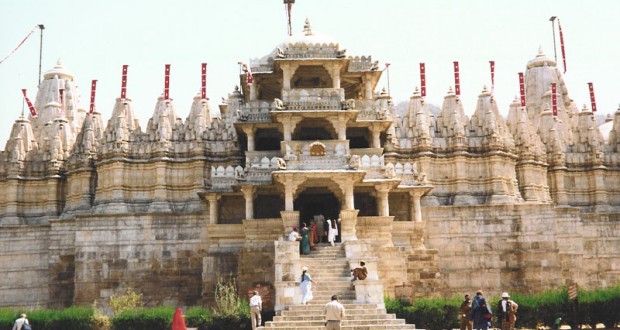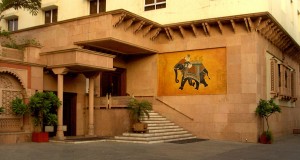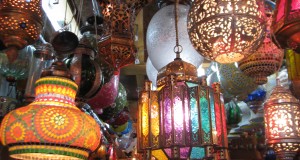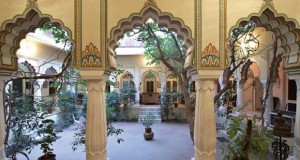Review Overview
Adhar Devi-Guru Shikhar-Achalgarh-Dilwara Jain Temples-Nakki LakeSun,, Point
Abu Town may be on the flat, but all the surrounding sights are not. Every place covered on tour involves a stiff, steep climb. When you’ve had enough exercise, hire dolis palanquin men) to carry you up.
First stop of the morning is Adhar Devi Temple 3 km (1 2/3 miles) out of town, dedicated to the patron goddess of Mount Abu tours. To reach this 500-year-old Durga temple, you eed to climb 220 steep steps, a taster of what’s to come. The black-faced daily the top is secreted in a cave under the rockface, and you’ll have to do a bit pf potholing to visit her. This temple is considered the oldest place of plIgrimage in Abu. It is called adhar (without support) because Devi’s statue is belived to be not man-made but rather a mystical manifestation, resulting from The I nt prayer of saints and sages. Set in pleasant woodland, full of the sound at ‘, Lag crickets, it gives fine views down over Abu. Back at the bottom, try a plate. 1 sliced tomatoes (popular thirst-quenchers) before reboarding the bus— they. delicious .
On next to Guru Shikhar (15 km: 9 1/2 miles), the highest peak in Rajasthan at 2m.there’s a small Vishnu temple with a 15th-century brass bell at the summit, vfdiewHsu of thrie sniurnouendging valeys and hils. It’s athe top of 30 steps. re palanquin if you are worn out. Still better, return to Guru Shikhar at sunrise The next stop is Achalgarh (11 km: 62/3 miles)—site of an ancient Shiva temple (AD 813), and a slightly less ancient Parmer fort (AD 900) partially restored). Instead of the usual lingam, the main temple contains Shiva’s toeprint (he once stood on Abu mountain to stop it moving away). This is at the bottom of a pit said to extend all the way down to the underworld.
Pilgrims of three faiths pay their devotions here: the Hindus for the toeprint, and for the holy spring where the Devi goddess helped the 15th-century Rana to summon water from the rock and relieve a severe drought; the Gains for the richly-carved Gain arch and architecture; and the Muslims, because it was a Muslim warlord who built the new Shiva temple on this site after an attack of guilt over destroying the original one. There are lots of charming little temples and shrines containing bright-eyed gods, also a fine brass Nandi and a huge old champa tree in the courtyard. Outside, near the car park, is Mandakini Kund, a huge tank with a stone archer and three striking stone buffaloes. These figures face onto ancient cave dwellings of Gain monks, hidden up on the densely foliaged mountainside.
According to legend, the tank was once full of ghee and three demons came in the form of buffaloes to drink at it each night. To stop them, the Parmer ruler Adipal killed all three with arrows. To see the pretty Gain temples above, take directions for the path up the hillside (10 minutes’ climb).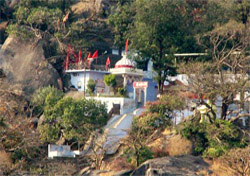
Finally, you come to the small village of Dilwara (5 km: 3 miles) with its five famous Gain Temples. Two of these, the Vimal Vasahi and the Luna Vasahi (Tejpal), represent the finest Gain architecture in India. They are open to non-Gains from 12 noon to 6 Om daily, and there’s an excellent free guide service. Security is a bit stiff though. Leather articles (and any ‘arms and ammunition’) must be left at the ‘clock room’. A prominent sign declares: ‘Women on their monthly course must not enter—those who do may suffer’. As a female visitor, be prepared to be quizzed at the entrance often in front of a crowd of inquisitive Indians. There’s a Rs5 camera charge and you can’t take photos of any Gain deities.
See first the Vimal Vasahi (Adinath) temple, built completely of white marble and dedicated to the first Jain tirthankar, Adinath. It is the earliest temple of the group, built in AD 1031 by the minister Vimal Shah for the Gujarat ruler Bhim Deva. Measuring 30 m long and 13 m wide, it took 1500 sculptors and 1200 labourers (working continuously) 14 years to complete. Entering via a series of 48 carved pillars, you’ll come to a room full of marble elephants, on one of which is mounted Bhim Deva himself. The central courtyard, a vision of sublime ornamentation and sculpture, houses the large bronze image of Adinath, with eyes of precious stones and a necklace of gems. Around it are ranged 52 identical cells, each with its small resident Jain figure. Everywhere you look in this temple, there’s a beady-eyed cross-legged deity staring right back at you. In a rear chamber, you’ll find the ancient blackstone statue of Adinath (said to have risen I rom the earth from below a peepal tree) which was the original cause of a temple being built on this site.
Move on to the Luna Vasahi (Neminatha) temple, built by two brother-ministers of the Gujarat ruler Viradhawaler in 1231, and dedicated to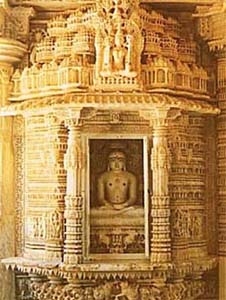 the 22nd tirthankar, Neminath. This has the same profusion of sculpture as the Adinath temple, but is notable for its technical perfection: every inch of marble is a masterpiece of intricate and delicate carving. Since each worker was paid in solid gold, and in direct proportion to the weight of marble covered, such attention to detail is perhaps not surprising. What is surprising is that this filigree fantasy-temple—with its cluster of translucent lotuses dripping from the porch dome, its glorious overhead panels of deities and attendants, its high-towered prayer hall and its massive statue of Neminatha-were all carved from a single massive block of Macrana marble. The overall effect is stunning. Other temples in the group include a 14th-century Adinatha temple and a 15th-century Parshvanatha temple.
the 22nd tirthankar, Neminath. This has the same profusion of sculpture as the Adinath temple, but is notable for its technical perfection: every inch of marble is a masterpiece of intricate and delicate carving. Since each worker was paid in solid gold, and in direct proportion to the weight of marble covered, such attention to detail is perhaps not surprising. What is surprising is that this filigree fantasy-temple—with its cluster of translucent lotuses dripping from the porch dome, its glorious overhead panels of deities and attendants, its high-towered prayer hall and its massive statue of Neminatha-were all carved from a single massive block of Macrana marble. The overall effect is stunning. Other temples in the group include a 14th-century Adinatha temple and a 15th-century Parshvanatha temple.
Either take the tour bus back to Abu town (it stops only an hour here), or stay longer—the temples are worth it—and return back down by the regular jeep service.
In the afternoon, go boating on Nakki Lake, perhaps the finest hill station lake in India. It is an artificial sheet of water, studded with tiny islets, fringed by beautiful woodland, and overhung by the famous Toad Rock (a natural toad-shaped boulder). (‘addle-boats are a waste of time—currents are too strong. Hire a rowing-boat, battle out to the centre of the lake, then relax.
Dusk marks the great exodus of tourists out to Sunset Point (2 km: 1 1/4 miles). It’s them accepted thing to do—now practically a tradition. To get there in comfort (i.e. avoiding the multitudes), hire one of Abu’s resident camels from the pony-rank at the town-end of Sunset road. This is great fun, and gets you noticed by every Indian tourist in town. At Sunset Point (it’s here you realise you’re on a mountain, c open plains stretching out for miles below) many of them are going to be far re interested in photographing you (with or without the camel) than the glorious sunset.
In the evening, Abu comes into its own. It is one of the few places in India with Any claim to relaxed nightlife. People return from Sunset Point to take a long, leisurely evening promenade, and the town streets are a mass of gaily twinkling electric lights. Sweet buns, ice-creams, ‘genuine Bombay omelettes’, pau bhaji snacks and ice-cold beers are peddled on the roadside, and below the pony-rank is a row of stalls brewing up Abu’s remarkable ginger tea. Nearby, ladies can buy the attractive mendi patterns (henna palm-paintings, traditionally painted on, but here sold as stencils: the pattern lasts 5 days) or colourful bangles, bracelets and bindi beautyspots. There are numerous street tailors, photography shops, paan stalls and cheap novelty-gift emporia. There’s even a ‘Character Building World Spiritual Museum’, where uninvited guides show visitors round the (strange) exhibition depicting the evolution of the world, then tell them how Lord Shiva will manage things after it has been blown up. If you need some light relief after this, try a short pony-ride round town.
RECREATION Apart from pony-riding and boating, there’s swimming at the Savera Palace Hotel’s pool (nominal charge for non-guests) or pleasant walking to local viewpoints including Lover’s Point, Honeymoon Point. For the best views, take any of the paths leading up from behind Nakki Lake to the hilltop (a 40-minute, 754-m climb). Abu also has a small wildlife sanctuary. To visit it, contact the Forestry Office (just up from the tourist office, open 70 am-5 pm).
SHOPPING Abu’s many ‘fun shops’ sell some of the worst tat in the world—useless plastic toys, ghoulish funny masks, hideous plaster gods, and ‘breakable educational zoological animals’. To see something better, visit Rajasthan Handicraft Emporium, near the bus-stand. Or Khadi Gramodyog Bhavan, opposite the pony-rank. To see something completely different, visit Cha Cha Museum, Abu’s biggest and oldest emporium. It is called a museum because most of its bizarre curios and antiques hang around for ages before finding a buyer.

